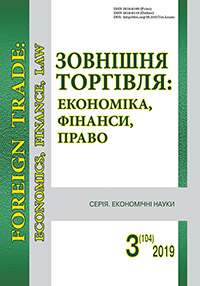Technologies of cryptocurrency security and block chain networks
DOI:
https://doi.org/10.31617/zt.knute.2019(104)08Keywords:
cryptosystem, blockchain, hash function, electronic wallet.Abstract
Background. The dynamics of the introduction of information technology in the banking sector in recent decades cannot fail to impress. It is difficult to overestimate the accomplished transition to electronic payment systems, the use of electronic digital signatures in banks’ document flow, the use of electronic money or digital currency. However, it is extremely important to focus not only on the positive aspects of new technologies, but also on the safety issues of their use, especially when it comes to money. It is quite relevant to study the issue of digital currency security.
The aim of the article is to study the applied security technologies for using digital currency on the example of Bitcoin cryptography and the security mechanisms of a decentralized distributed block chain network, on which Bitcoin cryptocurrency is based.
Materials and methods. The information base of the study was the work of foreignscientists, reports of financial institutions [5], electronic resources, raising the problems of using the digital currency. To achieve this goal, scientific methods of theoretical analysis, synthesis and analogies are used.
Results. Decentralization increases the level of cryptocurrency security, since if it is still possible to allow malicious intervention in the work of a single central authority, then any attempt to make changes to individual nodes of a distributed system is simply meaningless. Thus, the decentralization and application of a distributed registry in accounting for cryptocurrency is an important security aspect of the cryptocurrency itself. From the point of view of personal data protection, the anonymity of cryptocurrency can also be considered as an element of security technology. Cryptography as a security mechanism in the cryptocurrency payment system is used, firstly, at the stages of storing and transferring cryptocurrency, and, secondly, it is used when forming a distributed registry of transactions stored in blocks. In the first case, the modern cryptography is used to implement digital signature technology and classical cryptography for the possible protection of electronic purse store and transaction traffic.
Conclusion. The use of modern cryptographic methods for the new digital currency provides the necessary level of security against possible hidden and open fraudulent actions at all stages of the life cycle of cryptocurrency: generation, transmission, storage. The use in the payment system cryptocurrency the peering architecture of the distributed nodes and technology block chain significantly increase the security of the use of cryptocurrency.
References
Dr Garrick, Hileman, & Michel, Rauchs (2017). Global cryptocurrency benchmarking study. Cambridge Centre for Alternatve Finance. DOI: https://doi.org/10.2139/ssrn.2965436 [in English].
Juan A., Garay, Aggelos, Kiayias, & Nikos, Leonardos (2015). The Bitcoin Backbone Protocol: Analysis and Applications. 34th Annual International Conference on the Theory and Applications of Cryptographic Techniques, Sofia, Bulgaria, April 26-30, Proceedings. Part II. (pp.281-310). DOI: https://doi.org/10.1007/978-3-662-46803-6_10 [in English].
Joseph, Bonneau et al. SoK: Research Perspectives and Challenges for Bitcoin and Cryptocurrencies. www.jbonneau.com. Retrieved from http://www.jbonneau.com/doc/BMCNKF15-IEEESP-bitcoin.pdf [in English].
Reuben, Grinberg (2012). Bitcoin: An Innovative Alternative Digital Currency. Hastings Science and Technology Law Journal, January 6, Retrieved from http://scienceandtechlaw.org/bitcoin-an-innovative-alternative-digital-currency [in English].
CPMI report on digital currencies (2015). Digital currencies. Committee on Payments and Market Infrastructures. November [in English].
Cryptocurrency. en.oxforddictionaries.com. Retrieved from https://en.oxforddictionaries.com/definition/cryptocurrency [in English].
Nakamoto S. Bitcoin: F Peer-to-Pear Electronic Cash System. bitcoin.org. Retrieved from http://bitcoin.org/bitcoin.pdf [in English].
Technical background of Bitcoin addresses. en.bitcoin.it. Retrieved from http://en.bitcoin.it [in English].
Additional Files
Published
How to Cite
Issue
Section
License
Copyright (c) 2022 Foreign trade: Economics, Finance, Law

This work is licensed under a Creative Commons Attribution 4.0 International License.
This work is licensed under a Creative Commons Attribution 4.0 International (CC BY 4.0)







